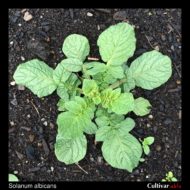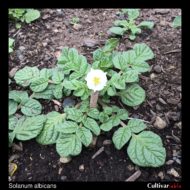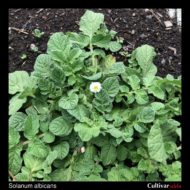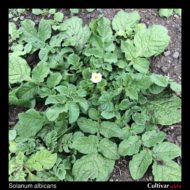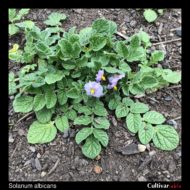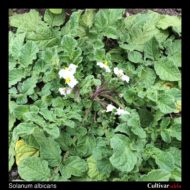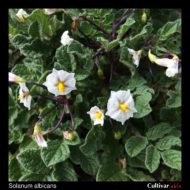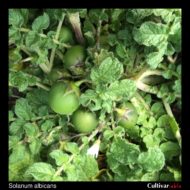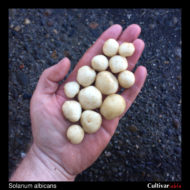No products in the cart.
Solanum albicans
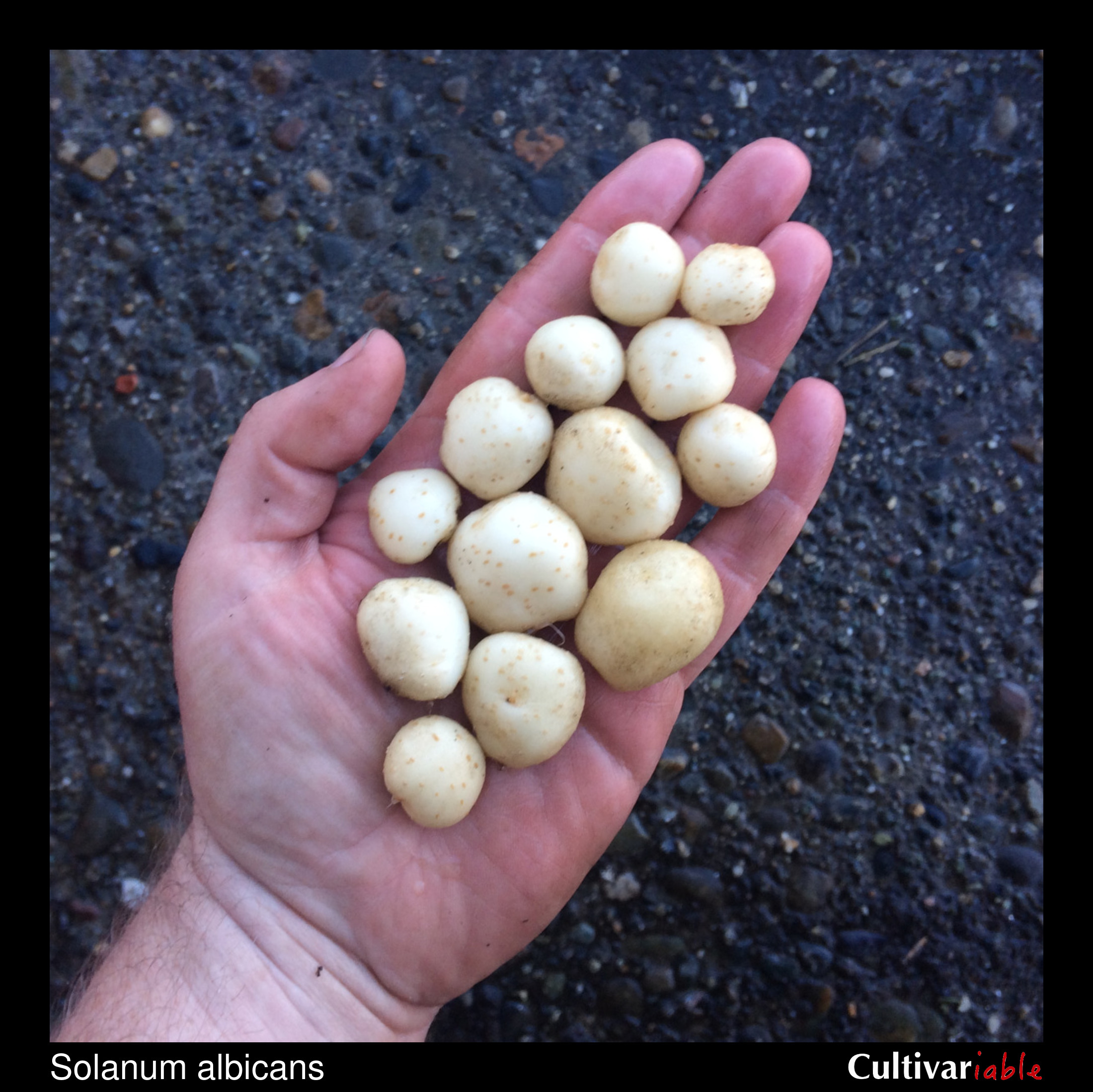
| Common Names | Aya papa, Pishgo papa |
| Code | alb |
| Synonyms | S. acaule subsp. albicans, S. acaule subsp. palmirense, S. acaule var. albicans |
| Clade | 3+4 |
| Series | Acaulia |
| Ploidy | Hexaploid (6x) |
| EBN | 4 |
| Tuberization Photoperiod | Short Day |
| Self-compatibility | Yes |
| Nuclear Genome | A |
| Cytoplasmic Genome | Unknown |
| Citation | Ochoa: Phytologia 54: 392. 1983. |
Description
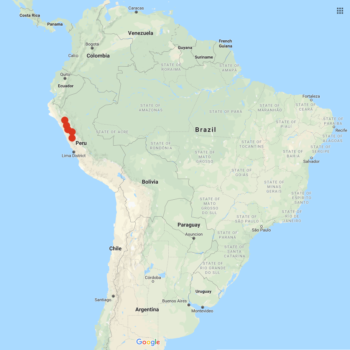
Solanum albicans is a hybrid species that is similar in many ways to Solanum acaule, one of its putative parents. Ochoa (2004) believes it to be a cross of S. acaule x S. sogarandinum, while Hawkes (1990) believes the male progenitor to be S. cajamarquense. It takes the form of a low-growing rosette, but is a little bit larger than S. acaule. Stolons run about 10 to 15 inches in length and often act as runners, being very shallow and forming new plants at nodes. Tubers are mostly round and 1/2 to 1 inch in diameter. Flowers are mostly white to light blue, occasionally darker. Fruits are round.
The specific epithet, albicans, means “becoming white.” It is formed from the Latin verb “albesco,” for “to become white.” While there is no completely standardized pronunciation for scientific names, the most common way to pronounce this species is probably so-LAY-num al-BIH-kans.
The natural range of S. albicans extends from Ecuador to central Peru at elevations from about 9,840 to 15,600 feet (3000 to 4750 m).
S. albicans, a South American species, is morphologically very similar to S. demissum, a hexaploid North American species. This is surprising, because the North and South Americans species have been long isolated from each other and have diverged significantly. Possible explanations include a common ancestor, more extensive prior distribution, or convergent evolution (Spooner 1995).
Resistances
Hijmans (2003) found that at least some accessions of this species were frost resistant down to 23 degrees F (-5 C). Vega (1995) found that this species is more frost tolerant than domesticated potato, with similar results to S. acaule.
| Condition | Type | Level of Resistance | Source |
|---|---|---|---|
| Alternaria solani (Early Blight) | Fungus | Somewhat resistant | Jansky 2008 |
| Phytophthora infestans (Late Blight) | Fungus | Not resistant | Gonzales 2002 |
| Pectobacterium carotovorum (Blackleg/Soft Rot) | Bacteria | Somewhat resistant | Chung 2011 |
| Potato Virus Y (PVY) | Virus | Not resistant | Cai 2011 |
Glykoalkaloid content
I have found no available reference on TGA content in S. albicans. The levels are probably similar to S. acaule. The tubers of most plants are bitter, but I have found some that have no detectable bitterness, so it ought to be possible to make edible selections of this species.
Images
Cultivation
I have found seeds of this species slow but easy to germinate using the standard conditions for S. tuberosum.
Breeding
Crosses with S. tuberosum
Ochoa (2004) reported that the cross of S. albicans x diploid S. tuberosum (as S. phureja) produced self-compatible progeny.
| Female | Male | Berry Set | Seed Set | Germ | Ploidy | Source |
|---|---|---|---|---|---|---|
| S. albicans | S. tuberosum 2x | High | High | Ochoa (2004) | ||
| S. albicans | S. tuberosum 4x | Moderate | Moderate | Jackson (1999) | ||
| S. tuberosum 4x | S. albicans | Minimal | Minimal | Jackson (1999) |
Crosses with other species
Jackson (1999) found 5-27% 2n pollen for varieties of this species.
| Female | Male | Berry Set | Seed Set | Germ | Ploidy | Source |
|---|---|---|---|---|---|---|
| S. albicans | S. acaule | High | Low | Ochoa (2004) | ||
| S. acaule | S. albicans | High | Low | Ochoa (2004) | ||
| S. albicans | S. boliviense (as S. megistacrolobum) | Moderate | None | Ochoa (2004) | ||
| S. albicans | S. brevicaule (as S. leptophyes) | High | None | Ochoa (2004) | ||
| S. albicans | S. candolleanum (as S. bukasovii) | High | Low | Ochoa (2004) | ||
| S. albicans | S. chiquidenum | Low | None | Ochoa (2004) | ||
| S. albicans | S. chomatophilum | High | Low | Ochoa (2004) | ||
| S. albicans | S. colombianum (as S. nemorosum) | None | None | Ochoa (2004) | ||
| S. albicans | S. immite | High | Low | Ochoa (2004) | ||
| S. albicans | S. lignicaule | Low | Low | Ochoa (2004) | ||
| S. albicans | S. medians (as S. arahuayum) | High | None | Ochoa (2004) | ||
| S. albicans | S. paucissectum | Low | None | Ochoa (2004) | ||
| S. albicans | S. raphanifolium | Moderate | Low | Ochoa (2004) | ||
| S. albicans | S. rhomboideilanceolatum (as S. ancophilum) | Low | Moderate | Ochoa (2004) | ||
| S. albicans | S. sogarandinum | High | Low | Ochoa (2004) | ||
| S. albicans | S. violcaeimarmoratum (as S. urubambae) | High | None | Ochoa (2004) | ||
| S. albicans | S. wittmackii | High | Low | Ochoa (2004) | ||
| S. boliviense (as S. megistacrolobum) | S. albicans | High | Low | Ochoa (2004) | ||
| S. candolleanum (as S. bukasovii) | S. albicans | High | Moderate | Ochoa (2004) | ||
| S. chomatophilum | S. albicans | High | Low | Ochoa (2004) | ||
| S. colombianum (as S. nemorosum) | S. albicans | None | None | Ochoa (2004) | ||
| S. raphanifolium | S. albicans | High | Low | Ochoa (2004) | ||
| S. rhomboideilanceolatum (as S. ancophilum) | S. albicans | Low | None | Ochoa (2004) |
References
Solanum albicans at Solanaceae Source

